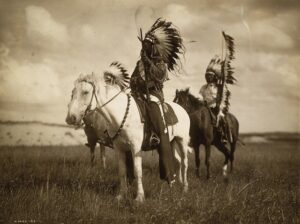Battle of Little Bighorn 1876
Background
The Battle of Little Bighorn was fought as part of the Great Sioux War of 1876.
Previously, the U.S. government agreed to accept that the Black Hills rightfully belonged to the Sioux tribe who considered these hills sacred. But in 1874, gold was discovered in the Black Hills and now the U.S. government wanted to take back the area from the Native Americans.
The Native Americans refused to give up their homeland which led to the war.
The Battle of Little Bighorn was one of the earliest battles of the war and one of the most famous victories of the Native Americans.
When and where did the battle take place?
The battle took place near the Little Bighorn River in Big Horn County, Montana. It took place on June 25, 1876, and June 16, 1876.

Commanders on both sides
The U.S. Army was commanded by Lieutenant Colonel George Armstrong Custer. He led an army of 650 U.S. soldiers.
The Native American warriors were led by many famous chiefs including Sitting Bull and Crazy Horse. These chiefs led a group of around 2500 warriors.
Before the Battle
The U.S. government wanted to force all the Native Americans out of the Black Hills area and relocate them on reservations. After giving an ultimatum, the government ordered the military to remove any Indians who were still in the area.
In June 1876, the U.S. army was informed that a large group of Indian warriors was gathering near the Little Bighorn River.
George Custer and his army were sent to take a closer look at the situation and attack the Indian encampment. They also expected to receive reinforcements from a much larger U.S. army. But the main body of the U.S. Army was engaged by another group of Indian warriors and so it couldn’t get to the battlefield in time.
The Fighting
When George Custer and his army reached near the village, the Indian warriors spotted them. So Custer decided to attack quickly and take them by surprise.
He divided his army into two parts. One of them was led by Major Marcus Reno and attacked the encampment from the south while Custer and his troops attacked from the north.
Reno and his men were quickly overwhelmed by the Indian warriors and retreated beyond the hills. Custer and his men fought back but were also overwhelmed.
They tried to fight back but they were badly outnumbered. After losing a lot of men, Custer and 50 of his men took a stand at a hill.
This is famously called ‘Custer’s Last Stand’. Here they fought back until all of them were killed.
Result and Aftermath
This was a major defeat for the U.S. Army lost nearly 270 men in the battle. The rest of the men who had escaped under Major Reno joined up with the larger U.S. army and were saved.
The Native American alliance of warriors claimed victory but it was short-lived. The defeat at the Battle of Little Bighorn led to more intense efforts by the U.S. government and ultimately, the Native Americans were defeated in the war and evicted from the Black Hills area.
Your Questions Answered
Who won the Battle of Little Bighorn?
The battle of Little Bighorn was won by the Native American alliance of warriors and was a major setback for the US army. Sitting Bull and Crazy Horse led around 2500 Native American Warriors.
Where was the Battle of Little Bighorn?
The Battle of Little Bighorn took place near Little Bighorn River in Big Horn County, Montana in 1876 between an alliance of Native American warriors and the US army.
Learn More about the Battle of the Little Bighorn 1876 at Wikipedia
